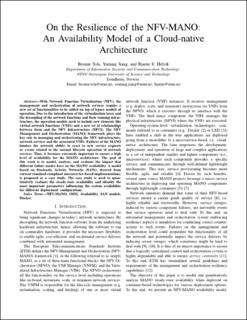On the Resilience of the NFV-MANO: An Availability Model of a Cloud-native Architecture
Chapter
Accepted version

Åpne
Permanent lenke
https://hdl.handle.net/11250/2675284Utgivelsesdato
2020Metadata
Vis full innførselSamlinger
Originalversjon
http://dx.doi.org/10.1109/DRCN48652.2020.1570604378Sammendrag
With Network Function Virtualization (NFV), the management and orchestration of network services require a new set of functionalities to be added on top of legacy models of operation. Due to the introduction of the virtualization layer and the decoupling of the network functions and their running infrastructure, the operation models need to include new elements like virtual network functions (VNFs) and a new set of relationships between them and the NFV Infrastructure (NFVI). The NFV Management and Orchestration (MANO) framework plays the key role in managing and orchestrating the NFV infrastructure, network services and the associated VNFs. Failures of the MANO hinders the network ability to react to new service requests or events related to the normal lifecycle operation of network services. Thus, it becomes extremely important to ensure a high level of availability for the MANO architecture. The goal of this work is to model, analyze, and evaluate the impact that different failure modes have on the MANO availability. A model based on Stochastic Activity Networks (SANs), derived from current standard-compliant microservice-based implementations, is proposed as a case study. The case study is used to quantitatively evaluate the steady-state availability and identify the most important parameters influencing the system availability for different deployment configurations.